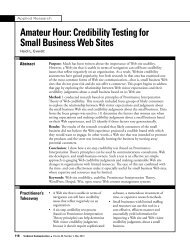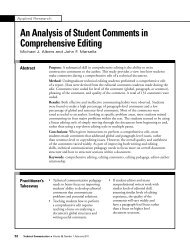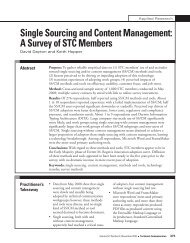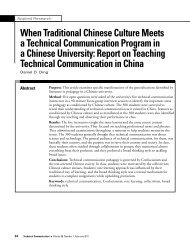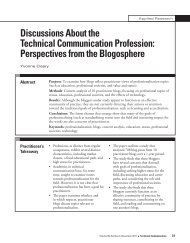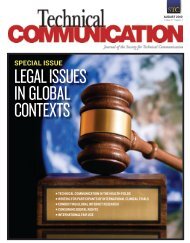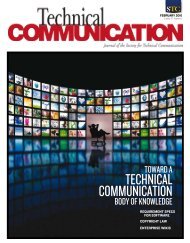The Use of Online Collaborative Writing Tools by Technical ...
The Use of Online Collaborative Writing Tools by Technical ...
The Use of Online Collaborative Writing Tools by Technical ...
You also want an ePaper? Increase the reach of your titles
YUMPU automatically turns print PDFs into web optimized ePapers that Google loves.
Applied Research<strong>Use</strong> <strong>of</strong> <strong>Online</strong> <strong>Collaborative</strong> <strong>Writing</strong> <strong>Tools</strong>was free, convenient, and easy to use. Also unlikeSharePoint, practitioners used Google Docs primarilyfor collaborative writing and equally for real-time andasynchronous collaboration. Respondents performedsome document management and communicationactivities with this tool, but its use was mainly forcollaborative writing. Practitioner opinion <strong>of</strong> GoogleDocs seemed very positive because it was seen asuser friendly; however, some users pointed out somedisruptive aspects they encountered when using the tool,such as printing and formatting issues.Student ResponsesAs a whole, technical communication students seemedto have positive attitudes toward OCWTs, despite theirdownsides, such as formatting issues. Most studentsused these tools on a weekly basis, with some dailyand monthly use <strong>by</strong> a smaller number <strong>of</strong> respondents.<strong>The</strong>se data suggest that these tools are familiar tostudents. Further, there seems to be some correlationbetween OCWT use outside the classroom andincreased frequency <strong>of</strong> use, suggesting that studentsmay encounter these tools more outside their curricula.It must be noted, however, that this observation couldbe attributed to the small sample size, so it cannot berepresented as fact.When OCWTs were not chosen to meet workor class requirements, students chose tools based onfeatures and price (for example, free). Some <strong>of</strong> themost common features were in the features-securitysubcategory, which included not only privacy but alsoaspects like user permissions. Student respondentsalso focused on esthetics, mentioning how simple,customizable, or attractive the tools’ interfaces were.Student respondents used OCWTs nearly equallyfor document storage and asynchronous collaborativewriting. In addition, the tools were used for real-timecollaboration roughly half as <strong>of</strong>ten as asynchronouswork. Another major use was discussion, which likelystemmed from using these tools within the classenvironment.Students seemed to feel quite positive toward toolsthat are user friendly and useful (that is, fitting theirneeds), yet they are turned <strong>of</strong>f <strong>by</strong> a lack <strong>of</strong> featuresand a clunky, unintuitive interface that is difficult tonavigate or search. Interestingly, these respondentshave negative opinions when features are lacking, butrarely mention positive opinions focused specifically onfeatures. Regardless, judging from their choices <strong>of</strong> toolsbased on available features and their negative opinions <strong>of</strong>tools they see as lacking features, it seems that technicalcommunication students are very features driven.Google Docs is clearly the most popular tool amongstudent respondents. It is both the most frequentlylisted tool overall, as well as being mentioned <strong>of</strong>ten asstudents’ most-used tool. Students have overall positiveopinions about Google Docs despite a few complaints.Students used this tool nearly equally for real-time andasynchronous collaboration, and they also used it asa document repository. Respondents chose this toolbecause it was free, but in some cases, they chose it forspecific features or because it was required for class orwork. One student mentioned choosing this tool wasbecause group members already had Google accounts—an interesting reason that was not listed for any othertools.<strong>The</strong> second most mentioned OCWT, PBWorks(formerly PBWiki), is interesting in that it was rarelymentioned as students’ most used tool. It was <strong>of</strong>tena secondary, or even tertiary, tool for students. Itwas frequently a requirement for class or work, oreven an arbitrary choice. Most respondents usedit as a document repository, but others used it forasynchronous collaboration and to provide commentsand feedback on peers’ work. Students’ opinions aboutPBWorks are slightly on the positive side <strong>of</strong> neutral;although it fit their needs, respondents found this tooldifficult to use.Blackboard, Moodle, and other LMSs accountedfor a reasonably large number <strong>of</strong> student-used OCWTs.This result is interesting not only because it wasrestricted only to student responses, but also becauseLMSs were never mentioned on the survey, nor didI encounter them within my secondary research. Yetseveral students mentioned using them for documentmanagement, collaboration, and communicationwithout any external prompting. However, LMSsshare many functionalities with other OCWTs, sotheir inclusion <strong>by</strong> student respondents is reasonable.In fact, several students mentioned specifically usingLMS wiki functions. Predictably, these OCWTs wereused primarily because <strong>of</strong> class requirements. Studentreactions to Blackboard (the most mentioned LMS)were barely on the negative side <strong>of</strong> neutral (a lack38 <strong>Technical</strong> Communication l Volume 60, Number 1, February 2013



